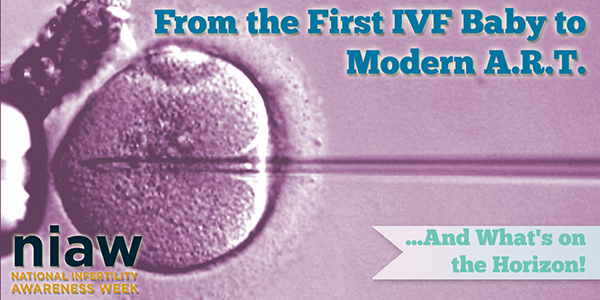Our National Infertility Awareness Week blog continues! Every day this week, we’ll feature one of our Circle of Support Sponsors as they share helpful information and advice about infertility, your options and coping. Today’s post is brought to us by Bronze Sponsor OvaScience.

Thirty-five years ago, there were few options for couples wishing to have their own children. The discovery of in vitro fertilization (IVF) techniques, an entirely new treatment option, delivered to the world Louise Brown, and more than five million babies since.
To bring such a wonderful option to so many required a number of great advances to improve the success of IVF. Those advances included the development and improvement of hormones used to stimulate the ovaries to produce healthy eggs, improvements in culture conditions, genetic screening and many others.
When Louise Brown was born, caregivers had very limited amounts of these hormones. Since then, new biotechnology methods have solved the original problems of short supplies and batch to batch variation of the hormones. In fact, these drugs have improved so much that caregivers are now able to tailor therapeutic regimens to each person to insure safe and effective egg development.
Culture conditions have been optimized to keep the delicate oocytes, or eggs, in a “happy” state until fertilization. Methods have been developed and optimized to effectively fertilize the eggs and culture the newly formed embryo. New incubation chambers keep the embryo in an environment that enables growth with minimal disturbance. By monitoring embryo growth, it is possible to select the healthiest embryos that are most likely to implant and grow into a healthy baby.
About 20 years ago, technology was developed that allowed us to analyze the genetic status of each developing embryo. We can now check the health of the entire genome from a few cells in the embryo that are destined to become the placenta. This is a significant milestone in helping to identify the healthiest embryo and achieve a successful pregnancy.
The wait to confirm a pregnancy – a time filled with hope, concern, anxiety and eagerness – has been greatly diminished. Tests that determine initial embryo implantation have become so sensitive that an indication of positive pregnancy can now be obtained within days rather than weeks.
Through these improvements, there has been an increase in “take home baby rates.” Even with these innovations, success rates, especially in women more than 35 years of age, are still low. Today, it is common to transfer more than one embryo to increase the likelihood of a pregnancy, but this also significantly increases the frequency of multiple births. While this can be a joyous occasion, multiple pregnancies also increase health risk to the mother and her babies.
As a result, there is a desire to provide elective single embryo transfer without decreasing IVF success rates. That is the transfer of a single embryo into a mother with a very high likelihood of progressing on to a healthy baby.
It is very likely that the next big advance in this field will be the use of all of the above technologies. In addition to these innovations, researchers at OvaScience are developing a new technology to enhance IVF success by supplementing the energy level inside her eggs using the woman’s own egg precursor cells, which are found in her ovaries. The Company is also developing potential next generation IVF technologies with the goal of maturing the woman’s own egg precursor cells into fresh, young, healthy eggs for implantation. If successful, this approach would allow women with eggs compromised due to cancer, age or other factors —many of whom are unable to undergo the hormone hyperstimulation required for standard IVF, to have their own healthy child.
We look forward to another 35+ years of progress and many future generations.
About the Author
OvaScience is a life sciences company focused on the discovery, development and commercialization of new treatments for infertility. The Company’s patented technology is based on the discovery of egg precursor cells (EggPCSM), which are found in the ovaries. By applying proprietary technology to identify and purify EggPCs, AUGMENTSM aims to improve egg quality and increase the success of in vitro fertilization (IVF). OvaScience’s team of scientists, physicians and advisers includes recognized leaders in the field of reproductive medicine.


Please hurry OvaScience. So many are hurting.